

Harvey Reid has been using partial capos since 1976, and though the idea has taken root many places in the world,and has been used effectively by thousands of players, teachers, and music therapists, it has been mostly ignored by the guitar press.
The History of the Partial Capo
by Harvey Reid
The history of the Third Hand Capo is a history of coincidences. I know of no one who has recorded or explored this idea in depth before me, though it is such a basically obvious idea, it would not surprise me to find out that lots of people have done it. What is amazing is that it has not become widespread. I published a 28 page book about it in 1980 and in 1982 recorded the first of my 32 albums that use it on at least some of the tracks.
In the Fall of 1976 I began experimenting with capo-ing only some of the strings of a guitar, while I was in the only period in my life when I was playing some 5-string banjo. (The issue of what happens when you capo the banjos's 5th string up to A or tune it up to A is exactly the same issue involved in every partial capo.) I was teaching guitar classes at the University of Maryland. By coincidence I happened to see an ad for a chord-forming capo in a guitar magazine, the very night I was sawing up Bill Russell capos to make A chords and trying to design a variable capo. I figured somebody had beat me to the idea, and thought no more about it for a while. I eventually contacted the company that made them, bought a few, and exchanged some letters with the inventor, not fully realizing how little he knew of how to use the device.
In 1979 I moved to Nashville to make my fortune, where I met Illinois songwriter Jeff Hickey, who asked me a question I still cannot answer when I showed him the capo at my apartment one night. He asked me "Why doesn't every guitar player on Earth have one of these?" He had some experience in running a music store, so rather than wait for our turn to get famous in Gnashville, we formed the Third Hand Capo Co. of Nashville, TN which began marketing the capo that fits any guitar and that allows any combination of strings to be clamped using a mechanism devised by Lyle Shabram. He invented the mechanism and his idea may have been partly inspired by the Insta-Tune, (which, coincidentally, was invented in Rockville, MD, and which I got as a free gift when I bought my first guitar because it was sitting on the counter at Wheaton Music, a few miles away, where I bought my Hoyer 12-string in the summer of 1971. I also got a free Jerry Odo Hi-Fi Pick. I still have my original Insta-Tune.
Here is a "What's New" column from Guitar Player Magazine April 1968, that shows the Insta-Tune. Someone recently sent me this clipping, because, coincidentally, unknown to me, they had called it a "third hand". I had never seen this until then. The useless device holds down the 5th fret of the string (and shifts over to hold down the G string at the 4th fret) so you can pluck the string with one hand, and work the tuning knob with your left hand, and not have to hold down the string to compare it to the next string while tuning.
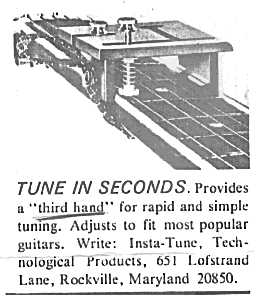
The "Chord-Forming Capo"
Lyle Shabram's Chord-Forming Capo was sold to a few people and a handful of music stores in California in the mid 1970's, with the subtitle "A Tool For the Creative Musician." Lyle was correct about this, though the instructions from his capo (shown below) and subsequent discussions with him indicated that he suspected (correctly) that there might be musical uses for his capo. As far as I know, he never found any of the ones any of us actually use, and the picture here (the original; instruction sheet with the capo) shows 2 diagrams of how to make an E chord with 2 capos, and how to capo both E strings at the Third fret with one capo.
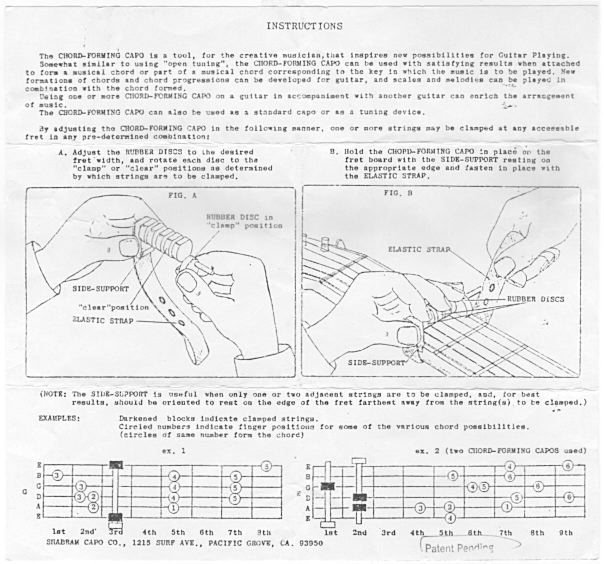
I published a book in 1980 called A New Frontier in Guitar, revealing what I knew about the subject, after realizing that the capo itself did people very little good without a lot of information on how to use it. Since then, most of the information in the book has been crammed into the instruction sheet that comes with each capo.
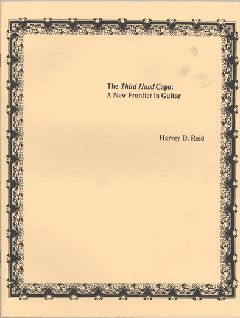 download
PDF of New Frontier Book
download
PDF of New Frontier Book
In 1982 when I recorded my first guitar album Nothin' But Guitar,
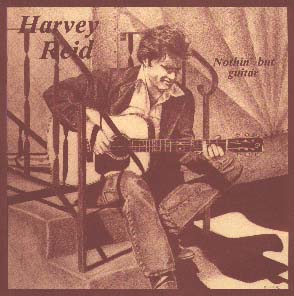
It included 7 cuts with the Third Hand. I believe this is the first commercially available recording made using a partial capo. Since then I have recorded over 300 tracks using dozens of different capo configurations, and only a handful of people ever noticed that something very different was going on. On stage I most often use sawed off straight capos, for speed and appearance. (I did not use a partial capo when I won the 1981 National Fingerpicking contest in Winfield, KS. ) Now that the idea has spread rather widely and other musicians are claiming to have developed this concept, I feel it is time to stand up and take credit for propagating the idea.
Most of those who use a partial capo use primarily the E suspended configuration, which I first started using in 1980. The first pieces I wrote for this configuration was "Suite in F: For the Duchess", which I recorded in 1983 on my 2nd LP "A Very Old Song" (The title cut, written in 1980 also uses this configuration, as does "I Will Learn to Love You," and "Dreamer or Believer".)
I have published 3 books about the capo (1980, 1983, 1984), and have written a chapter on it in the first college-level folk guitar textbook ever published (Modern Folk Guitar Knopf 1980, now McGraw-Hill, still in print in their textbook division). I developed a revolutionary method of using a partial capo to teach beginning guitar with simplified fingerings, (the Duck Soup Guitar method) and gave talks on the subject at the National Association of Music Therapists (1982) and National Assoctaion Of Music Educators (1983) conferences. I published an article (with co-author Dr. Terry Kuhn of Kent State Univ.) in the Journal Of Research of Music Education on the same subject. The capo has been in constant use by dozens of university music departments and music therapy centers ever since.
Recent Developments
Many people mistakenly assume that I invented the Third Hand Capo mechanism, and that I use only it. In fact, I was the first person to saw off a Shubb capo, which I did in the early 1980's, and have used ever since on stage instead of the clumsier Third Hand. There have been unconfirmed reports for years that various Third Hand Capos have appeared in the concerts of Dan Fogelberg, John Sebastian, Lindsay Buckingham, Ry Cooder, and others, but I have no evidence.
We gave a lot of Third Hands away to famous people at concerts and trade shows over the years, and many music stores have had them on their shelves since 1980. The Third Hand Capo Company has sold tens of thousands of these capos since 1980, in over 20 countries, and they have been given to many many well-known and not-so-known guitar players, most of whom did nothing with it. Chris Proctor got his in 1981, as did Seth Austen, and these two players jumped on the bandwagon quicker than most, and have been quite active, especially in using the Esus configuration. Below is an August 1982 letter from Leo Kottke claiming he was afraid of it, and showing his lack of understanding of it.
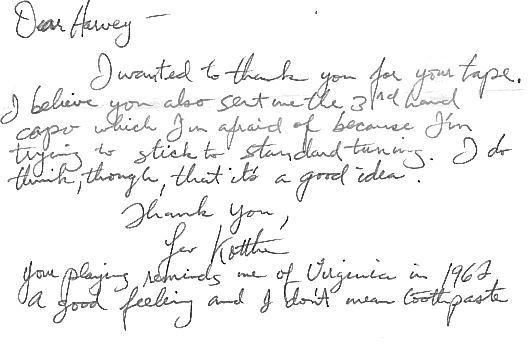
The recent expansion of the use of the idea of partial capoing owes a lot to several of my friends from New England who have used the device for years. Tom Pirozzoli is a songwriter from Sunapee, NH who took his Third Hand Capo to the Kerrville Folk Festival in Kerrville, TX (a mecca for modern songwriters) where he tells me he showed it to David Wilcox in May of 1989. Tom has told me that at that time David was not using any partial capoing in his playing, though in the last few years he has begun to use it quite a bit, almost exclusively the Esus configuration, for which he saws off a Kyser capo. (He has claimed in several interviews to have been using the idea for longer than this.) Cosy Sheridan, Cormac McCarthy and Rick Watson are also players from the Northeast who have begun to tour the country quite a bit in the last few years, and they have no doubt spread the capo around. (The list of players who have been given a capo and not used it is a much longer list.) At the Winnipeg Folk Festival in 1993 I did 2 guitar workshops with Adrian Legg, who at the time was not doing any partial capoing. Since then he has started to use one, especially the Open A configuration, I have been told.
I have recentlyreleased 2 compilations of my partial capo work that contain many things culled from my existing catalog, plus several new tracks available nowhere else, and some alternate takes of earlier things. I have now published a large number of books that carefully explain a great deal of valuable information about how to use partial capos, available from Amazon.com. The Capo Voodoo series consists of 10 books, plus another 7 in the Liberty Guitar series.
A large challenge now facing the partial capo issue these days is the issue of notation, and I have posted an open letter to the guitar industry about this problem.
If anyone knows any relevant historical information not included here, please notify me.
HARVEY REID
[Home]